The clown loach (Chromobotia macracanthus) is one of the most beautiful freshwater tank fish from the family Botiidae. They are bottom feeders but vivid and bright colored. They don’t hide during the day as other loach kinds. Further in the text, you’ll find out how to keep clown loach in a tank, breed, feed it, and select tank mates for it.
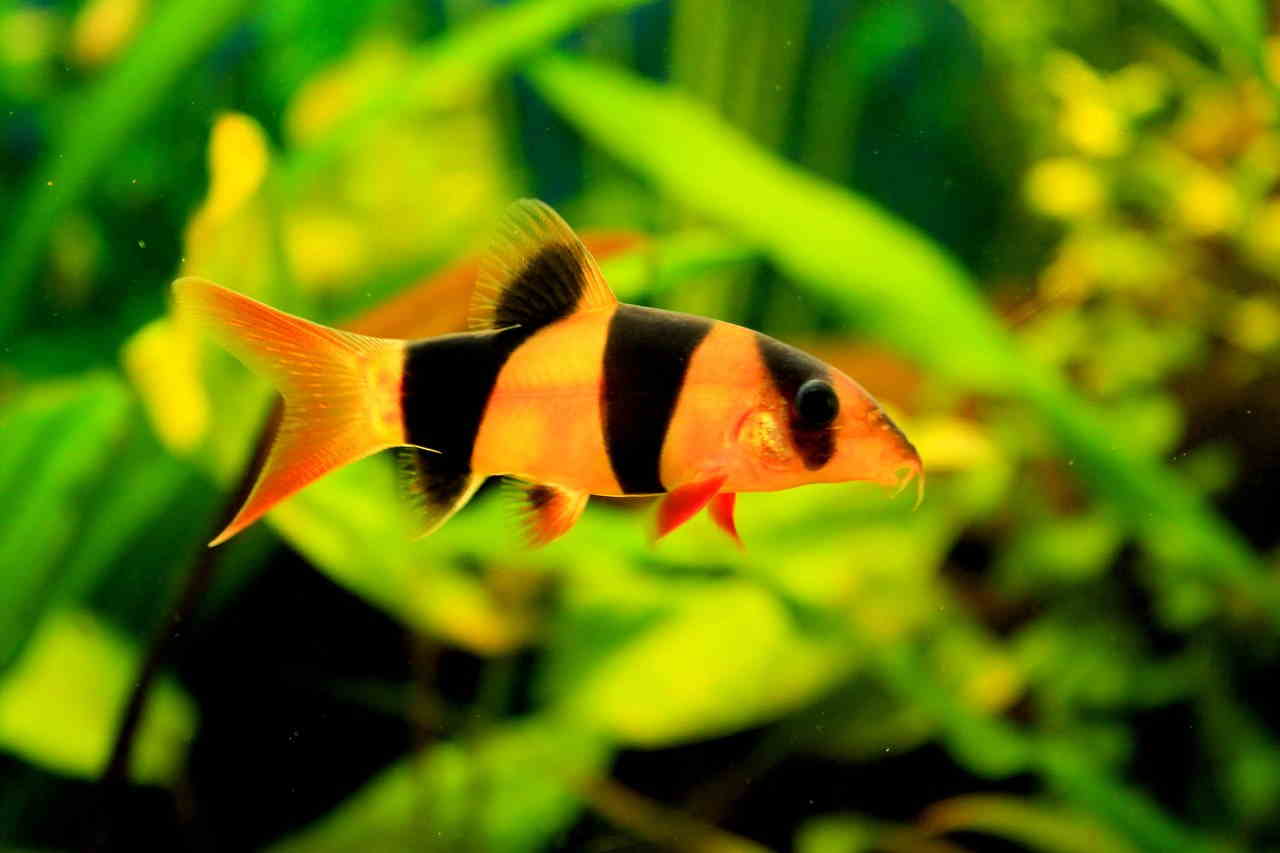
Contents
Habitat in the wild
Clown loach is the Botiidae family representative. The fish was first described in 1852. Pieter Bleeker (Dutch doctor, ichthyologist) was the first who mentioned this fish kind and classified the fish as a loaches fish class. Since 2004 clown loach was officially classified as a standalone kind of loaches family with the Greek name Chromobotia. Swiss ichthyologist Maurice Kottelat initiated this change.
Where are clown loaches from? The fish’s natural habitat is Malaysia, Borneo, Sumatra, and Kalimantan. It inhabits mainly river tributaries, but for the spawning period during the rainy season, when some areas are temporarily flooded, it migrates upstream to smaller tributaries and streams. Water temperature, pH, and muddiness may change depending on the season. In general, most clown loach native rivers have soft water of tea color, and they flow through the rain forests area.
Forested boggy streams have thick flora, a lot of shadow areas, and slow water flow. The bottom is covered with fallen leaves, pieces of tree branches, roots, etc. River main tributaries have a rather high flow speed that increases during the rainy season, and plants can hardly be found there.
In many areas of its habitat, the clown loach is considered a food fish and used as a meal. However, it is often caught in the wild and sold since it is in international demand. The largest fish marketing center is in Sumatra, in the city of Palembang, located on the River Musi that is famous for many loaches dwelling in it.
Recently, as the port city grows, a significant reduction of the natural fish habitat has been observed. First of all, this is due to uncontrolled capturing, water pollution, and destruction of natural habitats. All these cause major concern for the future of these fascinating fishes.
The second city on the scale of the clown loach capturing and sale is Pontianak city in West Kalimantan, located on the River Kapuas. There are also ecological problems here, but they are because of timber rafting along the river where fishes live.
The fish populations that dwell on Borneo and Sumatra islands differ slightly in their size and adult coloring. The most spread feature of clown loaches living on Borneo is the black-colored abdominal fin, while those dwelling on Sumatra have red-colored ones. It is supposed that a detailed study may lead to the discovery of two different fish kinds.
Considering the uncertainty and the inaccessibility of their habitats, for a long time, the scientists couldn’t get reliable information about the wild loaches pattern of life, behavior, and breeding.
In the wild, fishes spawns during the rain season, when the water level in the rivers rises. In their main habitats, the rain season starts in December and lasts till February. Before that, reproductive clown loaches start migrating upstream from rivers mainstream to smaller tributaries and river meadows.
Migration usually starts in September and lasts till October, but these terms can change due to climate and weather changes. Spawning takes place in these river branches, in boggy upper reaches, among reed grass. The fishes come back to their habitats, and sometimes they swim up to 200-300 km. The eggs that they left to drift with the flow and stop somewhere in streamside vegetation.
Ich fry appears there, and for a while, it feeds on different microorganisms. The juveniles stay in flooded areas even when the water starts going down. By that time (they are 2 months old), their size is about 30 mm, not counting tail length.
Currently, capturing large fish species in Indonesia is prohibited. For catching small ones, a traditional approach is used, which means using a bamboo stick with holes in each of its segments. These sticks have plummets made of stones, and then they hung the sticks above the streamside vegetation. At night, clown loaches swim into the holes, and in the morning, the fishermen get back and collect the captured fish. This way, small fish species from 20 to 80 mm long have been caught for many years, usually in February.
Another, more efficient technology is used on the River Batang Hari, on Sumatra. In this area, the fish lay eggs in flooded bottomlands. Locals gather the hatched larvae, grow them and then sell to sale agents. This way, every year, they grow and export about 10.000.000 species.
There is information that the species population that lives on Borneo island, namely in the Danau Sentarum lake system, don’t have seasonal migrations, even though the fact isn’t completely proven. The best time to get a clown loach is from April to May when in expert centers, the fish isn’t exhausted with a poor diet and a long stay in small-sized containers.
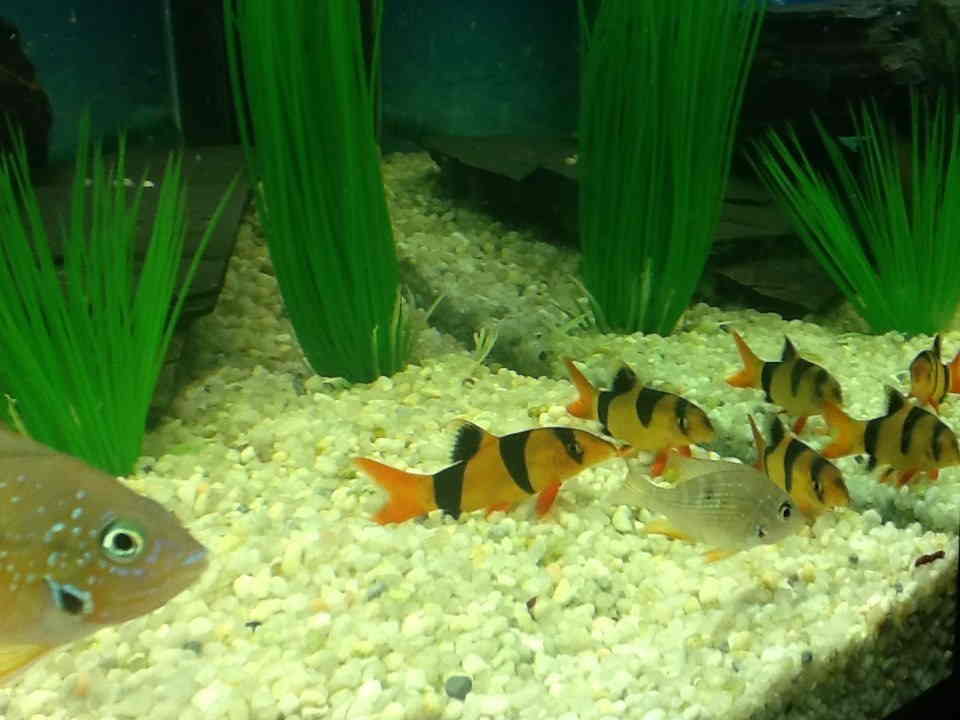
Description
Size
How big do clown loaches get?
Clown Loaches can grow to a substantial size, making them one of the larger species of loaches. Although in most references, it’s said that clown loach max size is about 30 cm (11.8 in), in the wild, there can be seen species about 40 cm (15.8 in) long. In a tank, they are significantly smaller, usually about 15–20 cm (5.9–7.9 in). Factors such as tank size, diet, and water quality can influence their growth rate.
Growth rate
How fast do clown loaches grow?
The majority of clown loaches are taken from their habitats in the wild, where the fish lives in forest streams and rivers in South-West Asia. In tanks, the fish grows slowly, and very seldom, it reaches its max size. But if provided with optimal tank conditions, the fish will grow up to 10-15 cm during a year.
Lifespan
How long do clown loaches live?
They are known to have a relatively long lifespan compared to many other freshwater fish species. In well-maintained aquariums, Clown Loaches can live for 15 to 20 years or even longer. When buying juveniles, one must remember that this lifespan is possible provided with good care, a spacious tank enough, and a diverse diet.
Nocturnal
Are clown loaches nocturnal?
As a rule, loaches are nocturnal creatures, so it is almost unnoticeable during the daytime. However, this isn’t about clown loach. It is very active during the day, but it’s a bit timid. It enjoys the company of fishes of the same kind. However, it can be kept in a tank and with other types of fishes.
Body
Clown loach has very thin scales, almost ingrowing into its body (no, they are not scaleless). This is a kind of problem since the fish’s skin doesn’t protect it from toxic substances dissolved in tank water. Therefore it’s better to add only clean and defecated water and not put any drugs intended to act on the fish’s scales.
Its eyes don’t have any protective cover, and in skin folds, under its eyes, the fish has doubled protecting spines. In the wild, they help the fish protect themselves in case of danger. Therefore they can be rather seldom seen when it is in a tank.
The spines appear when the fish is stressed. For example, when you take it out from the water. You should be attentive at this stage since they may get stuck in the net while large species can even injure you.
The clown loach has a rounded, elongated, and brightly colored body. Coloring varies from yellow to orange-red. It has 3 vertical stripes. The dorsal is black, and only at the bottom, it’s yellow. Young species have maximally bright coloring. It gets paler as they grow, but yet it remains quite appealing.
Pelvic fin and flukes are red and black. In the wild, such a colorful body helps the fish to hide in the plants. The fish mouth is made so that it’s very easy to dig the bottom and look for food. Clown loach has four pairs of barbels – these are vibrissae that help it find food in the muddy water of its native rivers.
One can see how the fish attacks by shooting with a protective spine with chattering noise when taking the fish out of the tank. When somebody tries to take the clown loach out of its tank, the fish thinks it is in danger and starts making chattering noise. Some species of this kind have a habit of chattering in the evening without any danger around. It’s rather difficult to picture this since the fish spines show up only for about half a second.
| Characteristic | Description |
|---|---|
| Scientific Name | Chromobotia macracanthus |
| Common Name | Clown Loach, tiger botia |
| Size | Up to 12 inches (30 cm) in length |
| Coloration | Orange to reddish-brown body with black vertical stripes |
| Lifespan | Up to 15-20 years in captivity |
| Native Habitat | Freshwater river systems in Southeast Asia |
| Social Behavior | Social and best kept in groups of 5 or more |
| Activity Level | Playful and active |
| Tank Size | Minimum of 75 gallons (284 liters) |
| Water Temperature | 75-86°F (24-30°C) |
| Water pH | Slightly acidic to neutral (6.0-7.5) |
| Diet | Omnivorous; feeds on small invertebrates, insects, worms, and plant matter |
| Compatibility | Generally peaceful but may be aggressive towards smaller or similar-shaped tankmates |
| Breeding Difficulty | Challenging; successful breeding is uncommon in home aquariums |
| Special Considerations | Sensitive to water quality; regular water changes and monitoring are necessary |
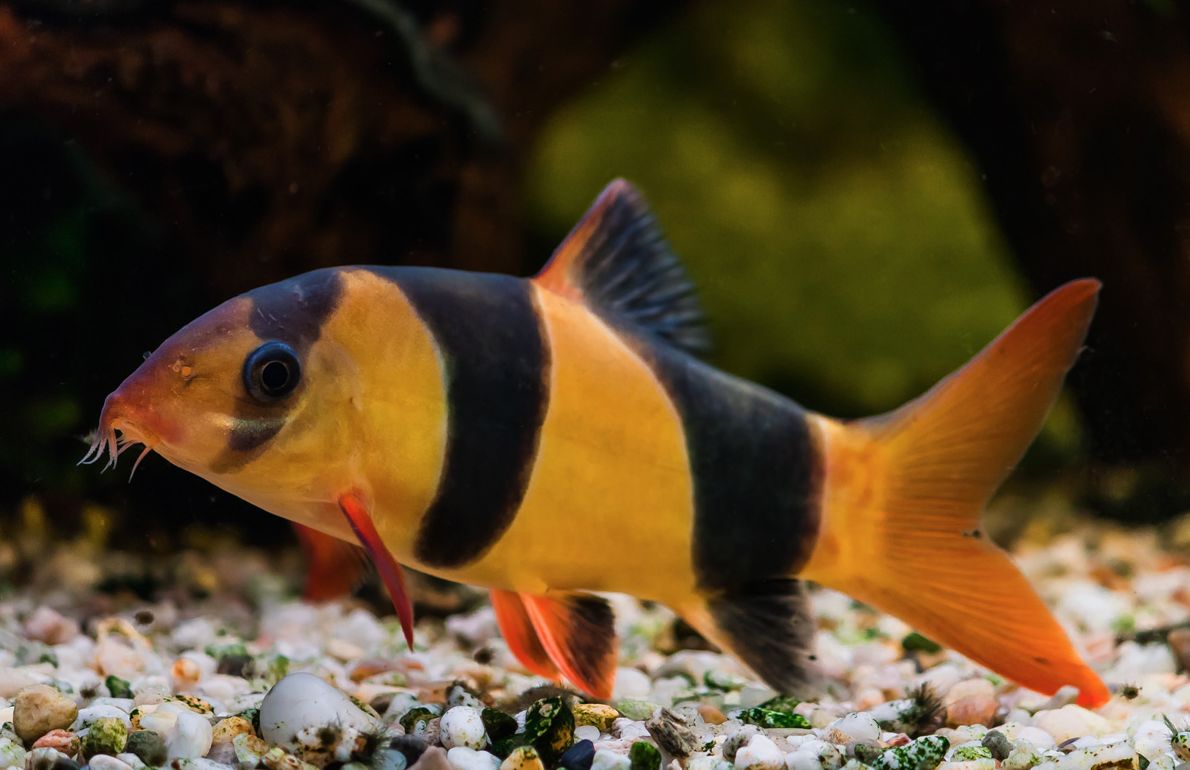
Difficulties in keeping
It is a fish of average difficulty to keep. This is a schooling species that form a complex social hierarchy. Thus they should be kept in a group of at least 5-6 species, while it’s better to be 10 and more. At that, they grow to be quite large so that they won’t survive in small tanks. However, clown loach, unlike other loach species, is active not only in the evening but also during the day. They are very spry, and it is difficult to take your eyes from them swimming in the tank.
Care and keeping in a tank
It is a completely peaceful fish, and it spends most of the time in the bottom part of the tank. Clown loach juveniles, as a rule, are very funny and active. When growing up, they become lazier and like lying in covers. The most spread fear of beginners aquarists is that they start to panic when the fish disappears for several days. Quite often, it happens with newly bought fishes.
Those who have had these fishes already know that sometimes they can lay on a side (even sleeping on the side) and scare the beginners. But after the fish had its rest, it continues swimming. Often clown loach lays on a side when pH is low because the water in a tank wasn’t timely renewed. However, it never was a problem. After lying for some time, the fish gets back to its normal state itself.
Tank size
This is a very active fish of schooling type. However, it’s important to consider the size of your aquarium when determining the number of Clown Loaches to keep together. The optimal size of a tank for a school of 3-5 clown loach species should be 100 gallons (454 liters). Please, consider the fact that the larger is the fish school and the tank, the more comfortable fishes feel: they grow more intensively, and intragroup aggression is almost absent. You can grow juveniles in smaller tanks, but you must partially renew water every day.
Tank wall height is important, and it should be not less than 60 cm (23,62 inches). Clown loach feels more comfortable in this condition. When put in smaller volumes with a lower water level, they’ll be stressed.
Water parameters
The clown loach prefers well-aerated, filtered water, and strong water flow should also be created in a tank. Tank water should be renewed once a week in the amount of 30% of the total amount. The fish feels better in soft water (5 – 12 dGH) with ph: 6.0-7.5, dGH 4-12. The optimal temperature range for clown loaches is between 75-86°F (24-30°C). They are native to the warm freshwater river systems of Southeast Asia, where they thrive in tropical climates.
In a tank, those clown loaches that have adapted to local water can dwell at higher water hardness (up to 25 degrees) and neutral or slightly alkaline water.
Can clown loaches tolerate salt? Definitely no. Moreover, considering that they are almost scaleless, salt will significantly irritate their skin.
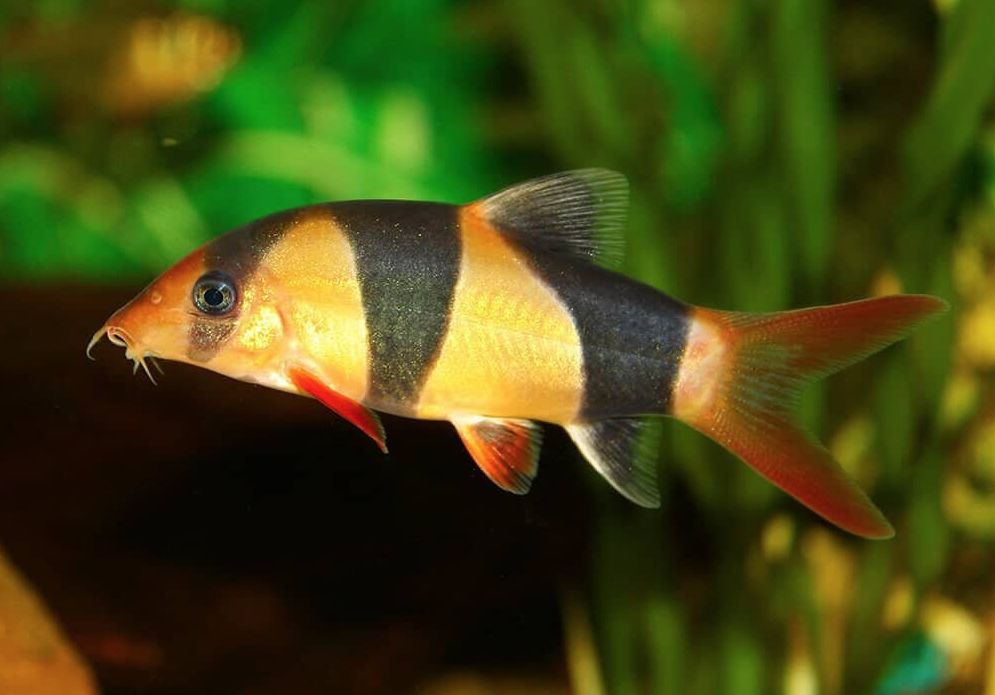
Tank setup: decorations and plants
All clown loaches require large numbers of shelters. However, it is you who selects tank decorations. Naturally decorating the tank suggests using natural substrate (large-grained sand or small-sized gravel) with the addition of smooth stones and pebbles, several snags, roots, or tree branches.
We should mention that the clown loach likes getting through small slits and cracks, so you should avoid using sharp-edged stones. All small slits where it can get stuck should be filled with silicone sealer for tanks. The way how loaches move deserves a special focus. Their ability to move fast (also with their tail frontwards), swim between the objects, getting in the tiniest slits is amazing. They swim mainly near the tank bottom looking for food, but they also can easily get to middle water layers. They can jump out of the water, so the tank must be covered.
Tank lighting should be dim, and the following plants that grow well in such conditions can be planted in a tank: Microsorum Pteropus and different kinds of Anubias. These plants will provide the fish with additional shade and covers.
Filtration
Clown loach feels well in the water, highly saturated with oxygen, and slight water flow in the tank. Thus, you should use proper tank equipment (it’s better to select a canister filter). The fish can’t stand an excessive amount of organic compounds and requires crystal clean water. For this reason, you shouldn’t put it into a biologically not settled tank. Weekly water renew should be 30% of the total tank volume.
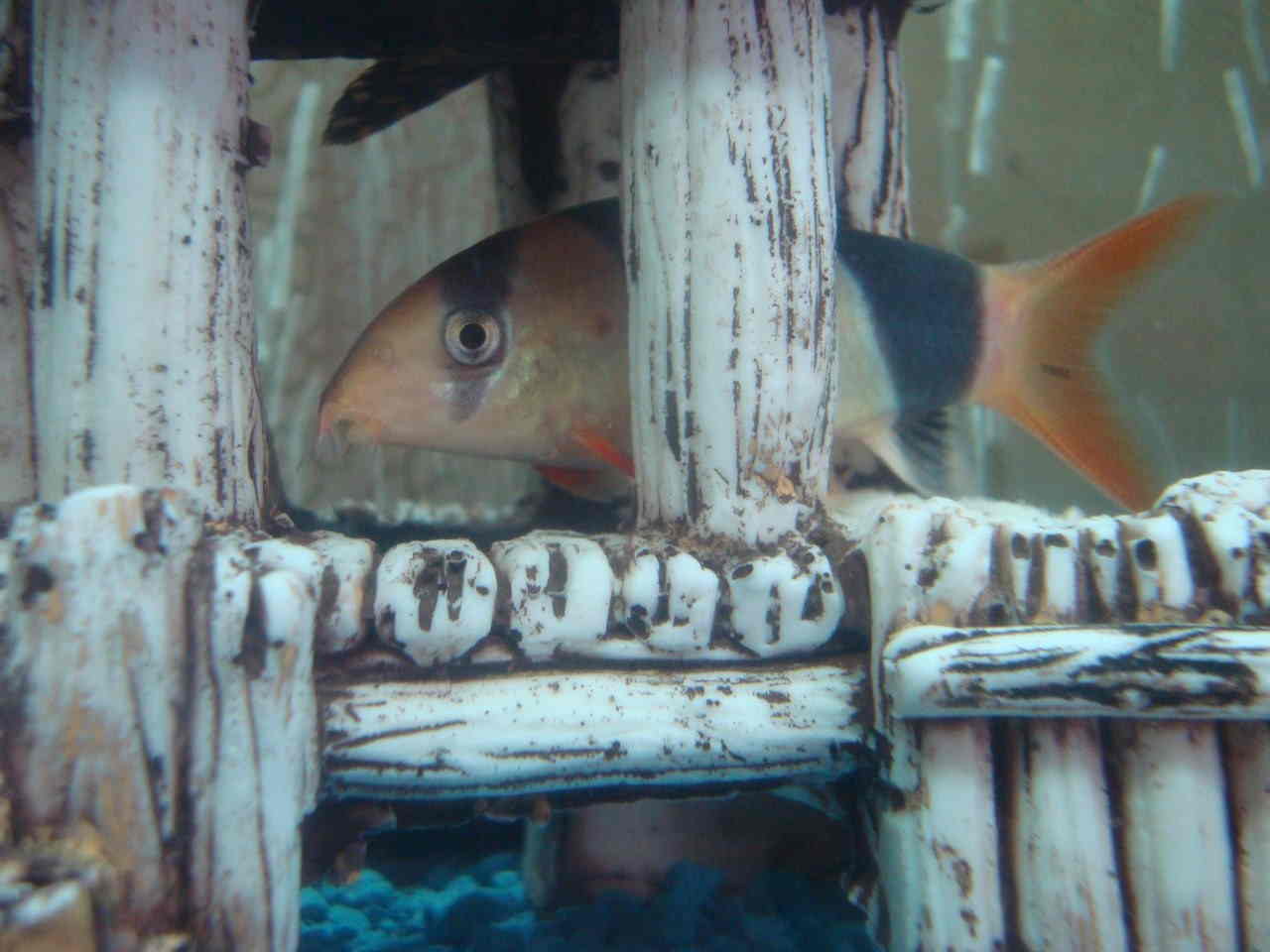
Diet
Clown loaches aren’t demanding in terms of food. Wild species feed on worms, snails, insect larvae, and other small, spineless species. They also fancy aquatic vegetation. Thus, the fish is omnivorous, and their diet must include both protein and plant food. It often happens that aquarists feed loaches with cucumber, melon, zucchini. You should remember that using these may worsen the tank water quality. A good choice, in this case, is special tableted food for bottom-dwelling fish.
Do clown loaches eat algae?
In the aquarium, Clown Loaches may nibble on algae that naturally develop in the tank. However, their algae consumption alone may not be sufficient to control significant algae growth. They are not considered “algae eaters” in the same way as some other fish species, such as plecos or certain types of catfish.
Feeding in a tank is easy. The fish is omnivorous, and it eats any type of feed. It eagerly feeds on qualitative flakes, granules, tablets. Live of frozen blood worms, tubifex, brine shrimp are also a good feed for the fish.
Usual loaches eat snails, including Melanie snails. If you’d like to decrease the population of snails in a tank, just put clown loach in a tank. However, I don’t recommend using them for snail control since they’ll eat snails only when hungry and opt for more tasty food during the rest of the time. It’s better to follow the approaches mentioned in our article about snail control.
The clown loach has some bad habits – they gladly eat plants, they even bite holes in Echinodorus. If there is enough plant food in the diet is decreases the damage the fish does to the tank plants. Plant food should be added to the diet: special tablets, cucumber, lettuce leaves, spinach, and peeled squash. In general, the amount of plant feed in the diet should be up to 40% of the total amount.
Best food for clown loaches – specially formulated sinking pellets or flakes that are designed for bottom-dwelling fish. These should contain a good balance of protein and nutrients.
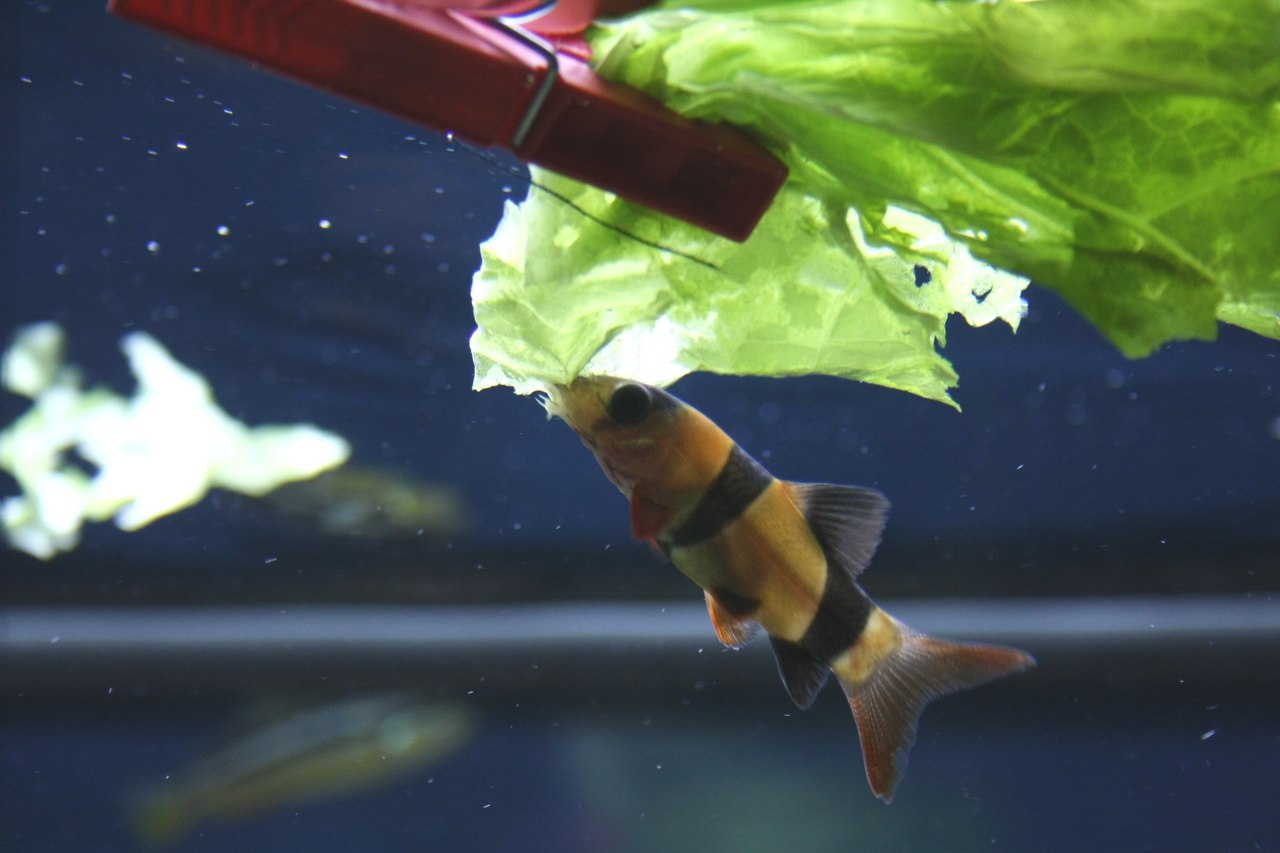
Behavior in the aquarium
Clown loaches are schooling fish, and it’s important to have several fishes of this kind in a tank. The minimal number is 3, but it’s better when there 5 or more species in a tank. In such school, there is a hierarchy, when alpha male scares more weak species off the food.
Provided with ideal tank conditions, the fish will demonstrate all its interesting behavior.
As a result of their fight for dominancy, when you put the clown loach into a new tank, some species may have their color fade. Such a phenomenon may also occur in a stable group since some species sometimes try to get a higher position in the hierarchy. This shouldn’t give cause for the aquarist’s concern.
Currently, there are no scientific studies of clown loaches’ behavior. Within amateur aquaristics, there were some observations made, showing that the species with the highest hierarchy position (alpha-species) influences all other group members’ behavior.
You may often see a young clown loach species swimming next to adult species and copying its every movement. At that, there may be several species like this. The reason for such behavior is unknown yet. Possibly, the group has to stay close when the river water level rises during the flood. Maybe this helps them to resist the water flow, and maybe this behavior has a communicative function.
One more interesting feature of clown loach is the ability to make some chattering noise. This way, the fish reacts to danger, and in the wild, it deafens the juveniles by this sound and hunts them. This fact should be considered when choosing tank mates so that it won’t scare small fishes.
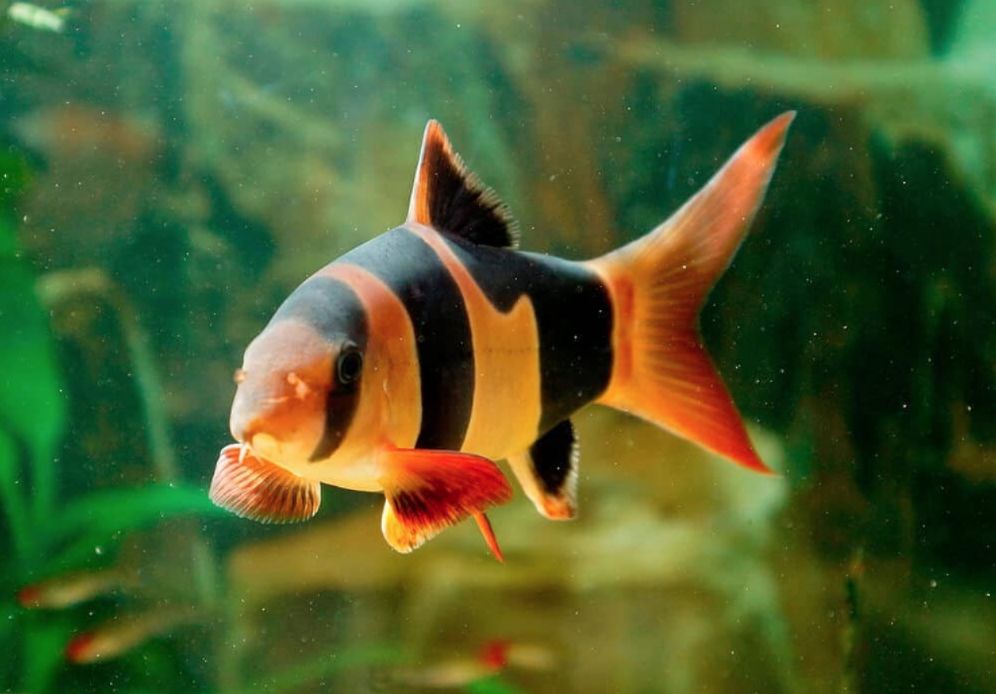
Tank mates
How many clown loaches should be kept together?
Clown Loaches (Chromobotia macracanthus) are social fish that thrive when kept in groups. It is recommended to keep them in groups of five or more individuals. By keeping them in a group, you provide them with a more natural and comfortable environment that promotes their social behaviors and reduces stress.
When Clown Loaches are kept in smaller numbers or individually, they may become more timid, hide more often, or exhibit less of their natural behaviors. Keeping them in a group allows them to establish a hierarchy and engage in playful interactions, which contributes to their overall well-being.
Providing adequate space, hiding spots, and suitable tankmates are also crucial factors to consider when housing Clown Loaches in a group.
Territory-dependent behavior is peculiar to clown loaches. Therefore some relatives do not get on well and fight from time to time. You can decrease their aggression by properly dividing the tank bottom with decorations and creating a sufficient number of shelters. Also, we should mention that loaches (even of different kinds, like yoyo loach) that grew in one tank since they were young demonstrate more loyal behavior towards each other. Still, quite often, they aren’t friendly towards newcomers.
Are clown loaches aggressive?
Clown Loaches are generally peaceful fish and are not considered aggressive. However, their behavior can vary depending on various factors such as tank size, individual temperament, and the presence of tank mates.
In some cases, Clown Loaches may exhibit territorial behavior, especially if they feel crowded or if they have similar-shaped tank mates. They might become more assertive or chase other fish away from their preferred hiding spots. It’s important to provide ample hiding places and enough space in the aquarium to help mitigate potential territorial issues.
While Clown Loaches are not typically aggressive towards other fish, they may become more active and playful, which can inadvertently stress or intimidate more docile tank mates. It’s essential to consider the temperament and compatibility of other fish species when housing them with Clown Loaches.
Compatible fishes
Large clown loaches are one of few fishes that can keep company for African cichlids. Often they are larger than the latter, so cichlids don’t make any attempts to attack them. Nevertheless, it’s important to create many shelters to avoid fights for the territory between the fishes. Also, you should keep in mind that loaches prefer softer water than African cichlids.
Large predator fish kinds from America (like oscar fish or green terror cichlid) sometimes may dwell with clown loaches. Large cichlids are very seldom interested in what happens on the bottom, and loaches can hide quite well. Don’t forget to feed the predators with quality and nutritious food since full-bellied fishes demonstrate more loyalty towards their tank mates than hungry ones. To exclude violent behavior, grown-up loaches are put to a tank with young cichlids. Nevertheless, you should monitor the predators’ behavior.
However, calm angelfishes and discus are one of the best tank mates for clown loaches. They are large enough to fight with the latter if necessary, and they do not dwell close to the tank bottom. They prefer the center area of the tank.
There will be no problem if loaches live together with lively tiger barbs. While the latter will search the bottom for something to eat, barbs play hide-and-seek with their relatives.
You can also keep clown loach with arowana. It dwells near the water surface and isn’t interested in anything behind it. The only thing is that the loach should be large enough so that arowana won’t treat it as food.
Incompatible fishes
Goldfish should be kept in species tanks, especially short-bodied species with modified bodies and long veiled fins. Active loaches may haunt slowly swimming goldfish and try to nip their fins.
Most popular bettas kinds – they have well-developed fins that loaches can easily damage, especially considering some bettas habit to have rest laying on the tank bottom.
Guppies are also not the best idea in terms of loaches tank mates. Firstly, they are too small compared to clown loach; secondly, they have long veiled fins that stop them from swimming fast.
These are territory-dependent fishes that actively protect their spots. Therefore, other bottom-dwelling representatives are not welcome. Thus, dwelling together with cory catfishes (like, panda cory) isn’t always a success, especially if the tank bottom square is small.
Gender differences: male vs female
Gender differences in all types of loaches are rather insignificant, and you can see if you have a clown loach male or female fish only when they become reproductive. However, even then, it’s not always done successfully. It’s very difficult to see between male and female by their appearance, except when the female has eggs inside her, and her abdomen is rounded. Male fishes have more developed pelvic fins. Fishes become reproductive at about the age of 5, and their body length should be not less than 12 cm.
Breeding
In some references, there is some information about the successful breeding of the clown loach in a tank. However, mainly breeding is performed in the fish farms using some hormone injections.
Earlier, all the fish sold on the markets came from Sumatra, but nowadays, this is different. Together with capturing and selling thousands of wild species, fish hatcheries of South-West Azia have been breeding clown loaches artificially using hormone injections for many years.
It is rather difficult to breed fish in a tank. The number of successful spawnings is very little, which is no surprise, considering the complexity of their natural breeding cycle.
Quite often, failures are considered to be due to using species that aren’t reproductive yet. However, the real reason is different. Wild species, when they migrate for spawning, have an average size from 12 to 20 cm and become reproductive when their size is 12 – 15 cm, while larger species don’t migrate and stay in the rivers mainstream all year round. This testifies that they don’t have any offspring after some specific age.
Despite there are some facts that it is possible to breed clown loaches in a tank.
Over a long period of time, only one such successful breeding attempt was acknowledged. It happened about 30 years ago, in a tank of some amateur aquarist from Montreal, who once, when taking a large burhead bush from the tank, found 39 grown-up clown loaches.
There was a strong filtration system in the tank using peat as a filtering substance, at that pH was about 6.2, water hardness – 2 dGH, and its temperature 28—29°C.
Standard water renews procedures allowed maintaining nitrites concentration less than 0,05 mg/l.
It is unknown how the breeding occurred since the fish were always hiding under the snags and fed only in the evening. They were fed with grated beef heart and pelletized feed with prawns.
Summarizing the experience, we can conclude the following:
- Firstly, a spawning tank must be large enough, especially when breeding large species.
- Secondly, strong and quality water filtration is required.
- Thirdly, for spawning, you should use old tank water with insufficient addition of fresh water (1/5—1/6 of the tank volume), hardness 5—6 dGH, pH 6.8—7.0, temperature 30-32°C.
Strong flow is a must. To create it, you should use specialized devices made for marine aquaristics. You should upgrade the spawning tank a bit (put Plexiglas insertions in its corners to ensure that the water flow won’t lose its energy in dead zones).
There is no sense in using mechanical pumps since the eggs like rainbow shark and Chinese Algae Eater ones constantly float in the water and move with the water flow from one place to another.
You can use flat stones and snags as a spawning substrate and put them on the spot with the strongest flow. The spawning intensity hinges on the water flow strength. There must be 3-4 males for one female in the tank. Hormone injections are done in stages.
Once the spawning is over, the breeders are removed. The water flow generator is turned off, and additional air sprayers are installed. At the water temperature of 29—31 °C in 2—3 hours, you can already see fertilized eggs – they are transparent. The eggs that became white weren’t fertilized, and they must be removed from the tank.
Eggs incubation continues from 18 to 20 hours, depending on the water temperature. Hatched larvae are extremely small and gather in the darkest places of the tank. The juveniles start to swim on the 4th day. At this time, you should feed them with the smallest rotifers kinds, cyclopes nauplii together with green Euglena.
The most critical time of the juveniles’ life is their first month of life. Thus, you must precisely monitor water and food quality during this time. By the end of the month, large clown loaches juveniles become 13-17 mm long, small ones – 7-10 mm, and they start to obtain their parents’ coloring.